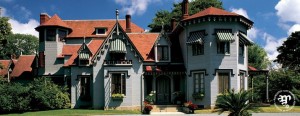Most people tend to visit the main 5 mansions when visiting Newport – The Breakers, Marble House, The Elms, Rosecliff and Chateau-Sur-Mer, but there are many others to see as well. An example of one of these “under the radar” mansions is Kingscote, which opens for the season on May 11th.
George Nobel Jones of Savannah, Georgia, wrote to Richard Upjohn, the founder of the American Institute of Architects, in September of 1839, asking him to build a cottage with “eight chambers” and a few sleeping quarters for servants, as well as “water closets” and a bath indoors. Neither man knew that the cottage that was designed would help represent a transition in Newport – a transition from a city struggling from the post-revolutionary economic collapse to a “thriving cosmopolitan resort.”
Many southern plantation owners spent summers in Newport as an escape from the heat of the south. They would stay in small hotels, private boarding houses or rented cottages. George Jones’ family was among this group of people, and he was one of the first to build a cottage used solely for his personal use in the summer. This was just another way Kingscote aided in making Newport a premier summer resort destination.
The house was completed in 1841, and is an example of Gothic Revival architecture. Gothic Revival began in the mid eighteenth century in England and features a smaller, human scale with a large variety of form and decoration. It relies on organic inspiration and is more picturesque than impressive. It uses asymmetry and a variety of textures in its gables, dormers and lattices. Kingscote has held true to this style of architecture and is one of the last surviving wooden structures of its size, period and style in the US.
Kingscote was sold in 1863, after the Civil War severed Jones’ ties with Newport, to William Henry Hunter King. King was not new to the Newport scene and his family had strong ties with China. He amassed a large collection of Chinese porcelains, paintings and furnishings that are still used to decorate the house. King, unfortunately suffered a mental breakdown and was admitted to a mental hospital in 1866. The house then began to get passed down to other members of the King family. In 1880 this cottage was officially registered as “Kingscote” and a year later, David King, added a three story addition to the home. This addition added the most lavish room in the house, the dining room. The last two owners and residence of Kingscote were, Maud Armstrong, the daughter of Ella Louisa Rives King, and her daughter Gwendolen. Ella was adamant about the preservation of Kingscote and Maud and Gwendolen held true to that, refusing to sell the estate to the government in order to build a school. When Gwendolen passed in 1972, she left Kingscote and all its furnishings to the Preservation society so that it could be enjoyed by others as it was enjoyed by her family for over a century.


